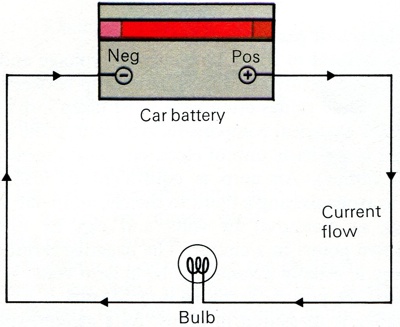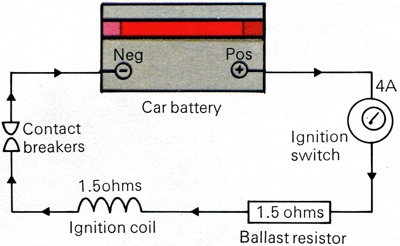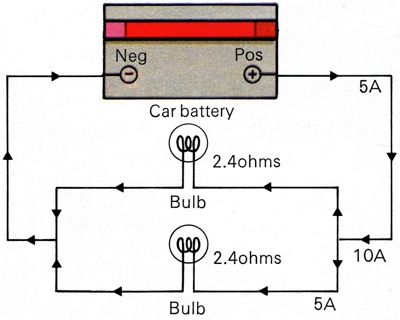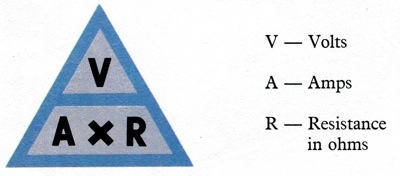Many car owners are nervous of their car's electrical system. The wiring, fuses and circuits can certainly cause confusion. But if the subject is approached logically, bearing in mind a few basic principles, a car's electrics become less of the daunting mystery that many people imagine them to be. Electricity is the flow of electrons along a cable or wire. Electrons are part of the atomic structure of materials and are far too small to be seen. The fact that electricity cannot be seen in action is one of the main reasons why many people find it hard to understand.
Electron Flow
Electrons require three things before they can flow - a suitable conductor, a circuit and something to push them around the circuit. Conductors are materials that allow electricity to flow through them. The best conductors are copper and aluminium, but most metals can be used as conductors. A material that will not allow electricity to flow through it is called an insulator. Rubber, PVC and porcelain are examples of insulators in common use. All cables that carry electricity are wrapped in an insulating sheath, to prevent the electricity flowing into another conductor.
If a conductor or wire has a large diameter, many more electrons will be able to flow through it than if it has a small diameter. Consequently wires and cable are available in different thicknesses, so that the right size cable can be used to match the flow of electrons or electrical current. If too small a cable is used for a given current flow, there will be excessive restriction or resistance to the flow of electricity and the cable will overheat.
The second requirement for electron flow is that the conductors should form a circuit. Electricity cannot flow along a wire unless the wire then returns to the source of power, because the same electrons flow round the circuit over and over again. This is why a battery always has two terminals or connections, one marked positive or "+", the other negative or "-". It is assumed that the electricity flows out from the positive terminal, through the circuit and then flows back into the negative terminal of the battery.
The
battery provides the third requirement for electrical flow. It pushes the electrons round the circuit. The battery can be thought of as a store of electricity that works in the same way as a cold water tank in a house. The water pressure in the tank forces the water through the pipes, much as the battery pushes the electricity round the circuit. The pressure of water in the pipe is equivalent to the voltage in the electrical circuit (usually 12v or 6v at the
battery). When a water tap is turned on water flows through the pipes. The rate of water flow will vary according to the size of the pipes. In the same way, the current, the amount of electricity flowing along a cable, will vary according to the size of the cable. The extent to which a cable restricts the flow of electricity is called its resistance. Resistance is also casued by components in the circuit. All electrical components, such as light bulbs, heaters and motors, resist the current to some extent.
 A very simple car circuit diagram. The current flows out of the battery through the positive terminal, runs into the bulb and returns to the battery.
A very simple car circuit diagram. The current flows out of the battery through the positive terminal, runs into the bulb and returns to the battery.

The ignition circuit is an example of wiring in series. This means that all components receive the same amount of current.

Car lights are always wired in parallel circuits. The supply of currnet is split into two, so the supply in each branch is halved.

Ohm's Law Triangle - a way of calculating electrical values.
|
Faults In An Electrical Circuit
Most circuits in the car's electrical system are reliable, but faults can occur. One fault that can be dangerous is the short-circuit. A short-circuit means that the circuit by-passes the component it should be supplying and the electricity flows straight back into the battery. A short-circuit can result from frayed insulation, when the plastic or rubber covering of the wires wears away until the conductors touch. Short-circuits are dangerous because the current flowing through the wires can cause them to overheat, which may result in a fire in the electrical system. For this reason most circuits are protected by a fuse. A fuse is a short strip of wire and has a low resistance. If a short-circuit occurs the circuit will lose the resistance of the components that have been by-passed, so the flow of current through the fuse will rise. The fuse will then heat up rapidly, melt and break the circuit, thus preventing the flow of current altogether.
Electrical Measurement
It is helpful to know how current, voltage and resistance are measured and the relationship between them, because these values often have to be taken into account when extra electrical components are fitted to the car. Current is the basic unit of electricity and is measured in Amperes (amps). An amp is equivalent to 6.28 billion billion electrons passing a point in the circuit in one second. Voltage is measured in volts and can be measured between two points in a circuit. The negative terminal of a car battery is usually assumed to be at zero volts, so it can be said that the positive terminal is at 12 volts.
Resistance is measured in ohms. As a general rule, one volt will cause one amp of current to flow through a resistance of one ohm. This relationship can be expressed by the formula Volts = Amps x Ohms which is called "Ohm's Law". A useful way of calculating any of these quantities is the Ohm's Law Triangle. The calculation is made simply by covering up the factor required, then working out the remaining sum. For example, if a new headlamp is being wired up it is important that the cable is of the right thickness. If it is too thin its resistance will be high and it might therefore heat up dangerously. The resistance of the bulb can be calculated by the triangle. If the bulb is operating on a 12 volt system and has a resistance of 2.4 ohms, the current consumption can be calculated by dividing the volts by the ohms:
- Current consumption of bulb = 12/2.4 = 5amps
The wire carrying power to the bulb must therefore be able to cope with 5 amps without overheating. To take another example, if an ignition coil is being changed it may be necessary to know the resistance of the coil primary winding so that a suitable replacement can be fitted. If it is known that the coil has a current consumption of 3 amps at 12 volts, it is clear from the triangle that the voltage must be divided by the current to find the resistance:
therefore a coil with a 3 primary resistance of 4 ohms would be suitable.
Electrical Power
Power is the rate at which a piece of electrical equipment consumes (or generates in the case of a dynamo or alternator) electrical energy. Power is measured in watts and can be calculated by multiplying the volts by the amps. This formula -
Watts = Volts x Amps - can be used for calculating the power of a certain component, or more usefully for calculating the current consumption of an electrical component when its rating in watts is known.
The calculation is also useful for assessing cable, switch and fuse sizes when fitting electrical accessories to the car, or checking existing circuits. For example, if a rear screen heater is being fitted and is rated at 42 watts, it is relatively easy to calculate its current consumption. Using the above formula the calculation is
amps = watts/volts - which, in this case is 42/12 = 3.5 amps. The fuse wires and switches controlling the heater must therefore be selected with this critical figure in mind.
Car Electrical Circuits - Series and Parallel
There are two types of circuit in common use in the motor car - series and parallel circuits. A series circuit is one in which the electrical components are wired together in a line, starting at the positive battery terminal and finishing at the negative. In this type of circuit there is only one route for the current, so the amps flowing through all the components in the circuit must be the same. An example of this is the primary ignition circuit, where the resistances add together to give a total of 3 ohms. The current flow around the circuit can therefore be calculated as 4 amps, when the contact breakers are closed.
In a parallel circuit more than one electrical component is connected across the same electrical supply or connections. Both headlamps are effectively connected across the battery and therefore both have 12 volts fed to them. Because the headlamp bulbs have the same resistance, the same current will flow through them. If that were 5 amps, then the total current drawn from the battery would be 10 amps. Therefore, with series circuits the current is the same through all the components and with parallel circuits the current in each parallel branch adds up to give the total current consumption of the electrical circuit.
Parallel circuits are often used with lighting systems. Their great advantage is that if one bulb breaks, current will still reach the others. If the bulbs were wired in series, the failure of one bulb would break the entire circuit. The electrical circuits in a car are divided up into groups. All the circuits are shown connected to the battery. The charging circuit is shown separately as it supplies electrical energy to the battery and the other circuits when the engine is running. The charging system is normally capable of supplying the charging current for the battery plus the current consumption of the other electrical circuits when the engine is running at speed.
The Charging Circuit
The charging circuit consists of an electrical generator, which can be either an alternator or a dynamo, together with its associated control equipment. The output of the generator depends on its speed which, as it is normally driven by the fan belt, depends in turn on the engine revs. The control equipment or voltage regulator ensures that once sufficient speed is reached by the car the voltage output of the generator remains steady at approximately 14 volts. The charging current, or amps, produced by the generator will depend upon the electrical load applied. A typical maximum output for a modern car alternator is about 40amps. Failure of the charging system results in the other car circuits being solely dependent on the battery, which will eventually become discharged and incapable of operating the circuits.
The Lighting Circuit
All the lighting equipment and associated circuits are independent of the ignition switch and include the sidelights, tail lights, headlamps and the number plate light. All lights on a car are wired in parallel so that failure of one lamp will not affect the others. To prevent total loss of lights, lighting circuits are not fitted with a main fuse. If fuses are used in lighting circuits, each part of the circuit is fused separately.
The Ignition Circuit
The ignition circuit supplies the high voltage required to operate the spark plugs, which ignite the fuel in the engine. The main components are the ignition switch, ignition coil, distributor and spark plugs. The distributor has low voltage and high voltage sections, the low voltage part being the contact breakers which switch the ignition coil to produce the high voltage (HT). The HT part of the distributor, which consists of the rotor arm and distributor cap, then distributes the HT current to the appropriate spark plug in the correct firing sequence.
The Starter Circuit
The starter solenoid, the starter switch (normally part of the ignition switch) and the starter motor are all linked in the starter circuit. The function of the motor is to crank the engine at sufficient speed to start it. Some starter motors are of the pre-engaged type, instead of the inertia drive type, in which case there is no separate solenoid as it is part of the starter motor. The solenoid acts as a relay to switch on the heavy current required by the starter motor. Because the starter motor draws a large current, initially about 300 amps, the cables are of a heavy gauge and any small resistance in the circuit will result in sluggish operation or failure of the starter motor to crank the engine.
Accessory Circuits
Accessory circuits control all the minor electrical components which include windscreen wipers, horns, instrument gauges, heated rear screens, heater blowers, indicators and hazard warning lights. These circuits are normally fused either in groups or singly and when there is a fault on one or more of the accessories the fuse should be investigated first having consulted your handbook. It should be clear from the group of accessories that has failed which particular fuse is at fault.
Wiring systems
A circuit must be continuous from one battery terminal to the other. Consequently there must be a feed cable to each electrical component and a return cable from the component to the battery. In practice, however, the steel car body is used as the return cable and this method of wiring is known as the "earth return" system. Instead of a wire returning the current to the battery, the circuit is simply connected to the car body. One battery terminal is also wired in this way. Most cars are wired "negative earth" which means that the negative terminal of the battery and the negative end of the circuit are both connected to the bodywork. Some cars are wired "positive earth", with the positive terminal connected to the body and the current flowing to the component through the car body and back to the negative terminal via the car's wiring.
This system has the advantage of nearly halving the number of cables required, which reduces manufacturing costs and saves space. This method cannot, however, be used on glass-fibre bodied vehicles. The cables used for wiring vehicles come in various thicknesses and have appropriate current ratings. The correct size of cable for a given circuit is selected by the car manufacturer and it is important that if circuits or accessories are added the correct size cable is used. A cable which is too small will overheat and a cable that is too large is a waste of material and takes up more space.
When a large number of wires need to be run to roughly the same point in the car they are carried in a loom. A loom is the complete set of cables bound in a thin plastic sheath with the appropriate connectors at either end. Wiring in looms makes initial assembly easier, keeps the cables tidy and prevents snagging, but makes tracing cables and repair difficult. To make it easy to identify cables in order to connect them to the appropriate component a colour code is adopted but unfortunately it is not standardized and different manufacturers use different codes. The colour coding adopted by different manufacturers is outlined in the next article in this series.
Vehicle manufacturers are trying to reduce the amount of wiring required and recent developments include a wiring loom tape, which is a flat tape having the wires embedded in it and parallel to each other. The tape can be glued or clipped to body panels and gives a neat wiring system which can be easily traced. This type of loom, called Fabrostrip, -has another significant advantage - it is relatively cheap to produce. Car manufacturers are always looking for ways of cutting production costs, in order to keep down the price of the finished car. Unlike almost all other car components, the conventional loom was largely handmade by highly skilled workers, which was an expensive process. The Fabrostrip looms, though, lent themselves to automatic-production and were consequently cheaper.



